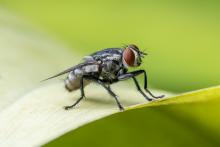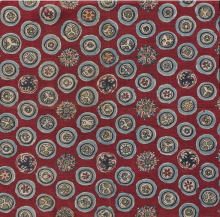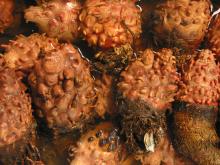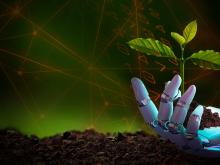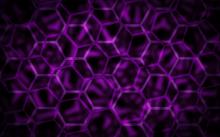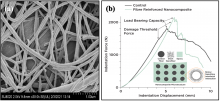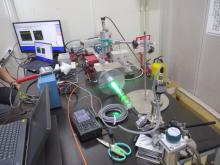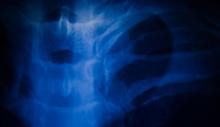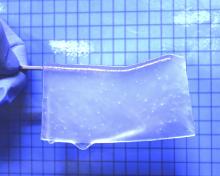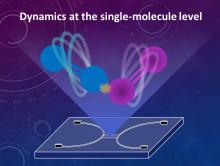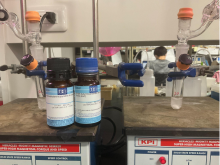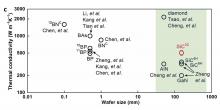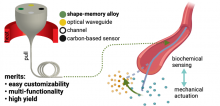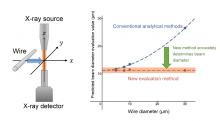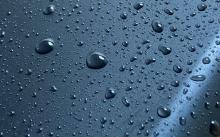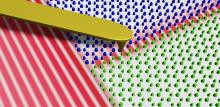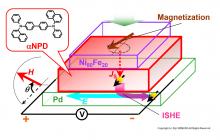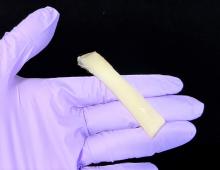Materials
News
18 Mar 2023
Scientists restore impaired kidney for the first time, How fibre composite fails when wet, Cleaner fish recognize themselves in pictures 🖼️🐟& The source of black carbon in the sea. Read all in the latest Editor's Choice. Plus our magazine Asia Research News 2023 is out now 🎉!
13 Mar 2023
Osaka Metropolitan University scientists succeeded in directly observing how LECs—which are attracting attention as one of the post-organic LEDs—change their electronic state over time during field emission by measuring their optical absorption via lamp light irradiation for the first time. This research method can be applied to all light-emitting devices, including not only LECs but also organic LEDs. This method is expected to reveal detailed electroluminescence processes and lead to the early detection of factors that reduce the efficiency of electroluminescence.
12 Mar 2023
Derived from the Gujarati word saras, meaning "beautiful", Sarasa cloth is believed to have been introduced to Japan as a trade textile by the Dutch during the Muromachi period (1336–1573).
08 Mar 2023
Modifying the active layer architecture at the heart of organic solar cells brings a big leap forward in efficiency.
03 Mar 2023
An international collaboration is developing coating materials that could make windows better insulators.
03 Mar 2023
Asia Research News monitors the latest research news in Asia. Some highlights that caught our attention this week are that COVID is transmissible between dogs, a new material created to replace extracted teeth, and a fungi-eating plant that was thought to be extinct.
03 Mar 2023
Hi-tech electrocatalysts made from seashells and waste animal blood could help build sustainable batteries, fuel cells and other electrochemical systems.
03 Mar 2023
Machine learning algorithms allow analysis and characterization of the atomic arrangement of silicon surface superstructures without the need for human expertise.
28 Feb 2023
A model that rapidly searches through large amounts of materials could find sustainable alternatives to existing composites.
28 Feb 2023
2.5-dimensional materials promise new applications for artificial intelligence, electronics, automobiles and the energy sector.
28 Feb 2023
A team of researchers from Universiti Teknologi Malaysia and Universiti Malaysia Pahang has successfully developed an electrospinning method for producing Nylon Nanofibres for use in carbon fibre composites to enhance the impact properties of carbon composites.
27 Feb 2023
A collaborative research group from Tohoku University and the Toyohashi University of Technology has invented a new and efficient method to create metallic plasmas from solid metals under a strong magnetic field in a microwave resonator.
27 Feb 2023
Scientists at Tokyo Medical and Dental University have discovered a new type of bone repairing material that could be used to more precisely fix bone defects.
24 Feb 2023
Synthetic hydrogels were shown to provide an effective scaffold for neuronal tissue growth in areas of brain damage, providing a possible approach for brain tissue reconstruction.
21 Feb 2023
Researchers from Osaka Metropolitan University have developed principles and technologies of nanofluidic devices to freely manipulate nanomaterials, biomaterials, and molecules at the single-molecule level using fundamental technologies such as nanofluidic processing, functional integration, and fluidic control and measurement, which has pioneered the way to integrate various fields under nanofluidics.
17 Feb 2023
Tree rings forecast extreme weather in central Asia, Squid 🦑and chemistry make versatile hydrogels, James Webb telescope reveals the earliest galaxies & Reducing negative effects of screen time. Read all in the latest Editor's Choice. Plus our latest journalist resource "Experts for Media: Antimicrobial Resistance "🦠.
16 Feb 2023
Amide bonds are important functional groups in medicinal chemistry and account for roughly 16% of all reactions performed in drug-discovery research. Some amide bond reactions using pharmaceutically important nitrogen-containing heterocyclic compounds, such as indole, carbazole and pyrrole, rather than amines are not efficient using conventional production methods. In a recent study, a team of leading chemists developed a novel one-pot reaction to efficiently form amide bonds using low-reactivity, nitrogen-containing heterocyclic compounds and carboxylic acid without special equipment or heat.
13 Feb 2023
A research group from the Graduate School of Engineering at Osaka Metropolitan University has shown that 3C-SiC exhibits high thermal conductivity equivalent to the theoretical value, based on thermal conductivity evaluation and atomic-level analysis, for the first time. They demonstrated that a 3C-SiC film on silicon substrate had a high thermal conductivity and expect that fabricating large-diameter wafers can be achieved at a low cost. The discovery should lead to improved heat dissipation in everyday electronic devices.
09 Feb 2023
A research team led by an associate professor at Tohoku University has developed a microscopic fiber equipped with actuators and biochemical sensors. The breakthrough could be used to develop smart catheters and lead to further advancement in robotics.
07 Feb 2023
A research group at Osaka Metropolitan University has derived a new evaluation method for the measuring the size X-ray microbeams (diameter) through mathematical analysis. The group then verified the validity of the mathematically derived evaluation method by measuring the diameter of X-ray microbeams using metal wires of various diameters with an X-ray fluorescence analysis system for small areas and found that it was possible to calculate the beam diameter more accurately than the previous conventional evaluation method.
05 Feb 2023
Scientists from two Asian universities, namely Universiti Teknologi Malaysia (UTM) and Newcastle University in Singapore, have completed a study to understand how the mechanical behaviour of carbon fibre reinforced epoxy composite laminates could be compromised by moisture seepage.

03 Feb 2023
In situ observation and recording of important liquid-phase electrochemical reactions in energy devices is crucial for the advancement of energy science. A research team led by a scholar from City University of Hong Kong (CityU) recently developed a novel, tiny device to hold liquid specimens for transmission electron microscopy (TEM) observation, opening the door to directly visualizing and recording complex electrochemical reactions at nanoscale in real-time at high resolution. The research team believes that this innovative method will shed light on strategies for fabricating a powerful research tool for uncovering the mysteries of electrochemical processes in the future.
03 Feb 2023
Traditional hydrogen peroxide production is energy and emission intensive, and so scientists have sought to synthesize it electrochemically. But tailoring the cobalt-nitrogen-carbon (Co-N-C) catalyst has been challenging. Using a theoretical prediction, which was then experimentally verified, an international research group has designed a Co-N-C catalyst that alleviates this problem.

31 Jan 2023
Organic photovoltaics (OPVs) are a promising, economical, next-generation solar cell technology for scalable clean energy and wearable electronics. But the energy conversion loss due to the recombination of photogenerated charge carriers in OPVs has hindered further enhancement of their power conversion efficiency (PCE). Recently, researchers from City University of Hong Kong (CityU) overcame this obstacle by inventing a novel device-engineering strategy to successfully suppress the energy conversion loss, resulting in record-breaking efficiency.
30 Jan 2023
Everyday electronics, such as our phones, employ surface acoustic wave devices for frequency filtering and sensing. But this consumes a lot of energy, serving as a drain on battery life. Now, a team of researchers has developed a new acoustic waveguide based on the mathematical concept of topology, which will help alleviate this problem.
29 Jan 2023
The Kailasanatha Temple at Ellora is the largest monolithic rock-cut monument in the world. Considered to represent the victory of its patrons, the Rashtrakuta Dynasty, over the Chalukyas, the temple is widely considered remarkable for its size, standing at 32 metres high and 78 metres long.
24 Jan 2023
A research group, at the Osaka Metropolitan University Graduate School of Engineering, has succeeded in measuring spin transport in a thin film of αNPD molecules—a material well-known in organic light emitting diodes—at room temperature. They found that this thin molecular film has a spin diffusion length of approximately 62 nm, a length that could have practical applications in developing spintronics technology. In addition, while electricity has been used to control spin transport in the past, the thin molecular film used in this study is photoconductive, allowing spin transport control using visible light.
20 Jan 2023
Overeating mechanism: why "eating just one chip"🍟 is impossible, Measuring hidden energy of gamma-ray bursts, Marine species that can adapt to ocean acidification & A rough start can lead to a strong bond, Read all in our first Editor's Choice of 2023. Plus our interview on what dengue vaccine approval in EU💉means for global dengue protection.
20 Jan 2023
The natural abilities of squid tissues and the creativity of chemists combine to take hydrogel research in new directions.
Events
Sorry, no events coming up for this topic.
Researchers
Sorry, no researchers coming up for this topic.
- « first
- ‹ previous
- 1
- 2
- 3
Giants in history
Abdus Suttar Khan (c. 1941 – 31 January 2008) was a Bangladeshi engineer who spent a significant part of his career conducting aerospace research with NASA, United Technology and Alstom.
Lin Lanying (7 February 1918 – 4 March 2003) was a Chinese material engineer remembered for her contributions to the field of semiconductor and aerospace materials. Lanying was born into a family who did not believe in educating girls and she was not allowed to go to school.


